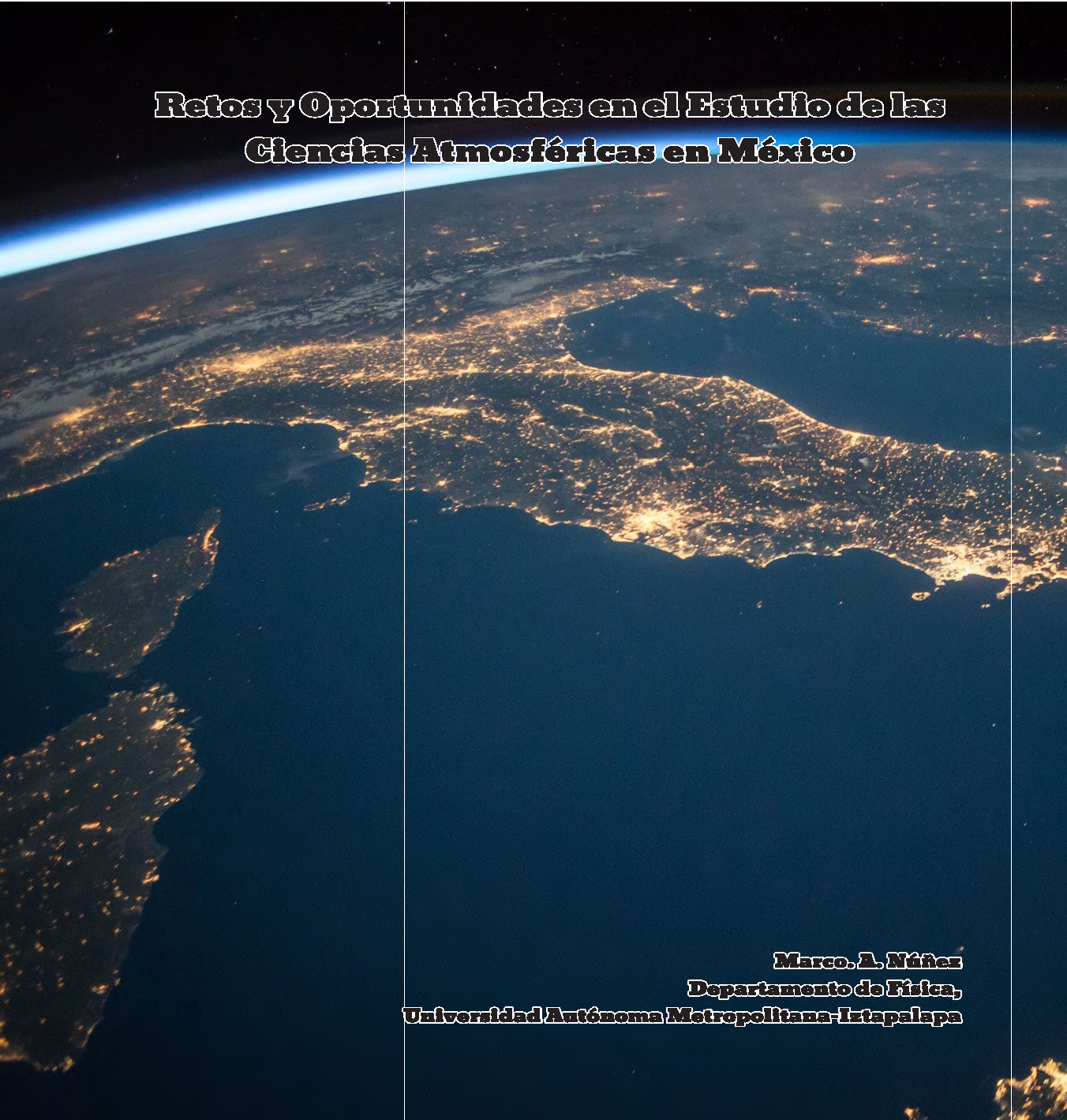Retos y Oportunidades en el Estudio de las Ciencias Atmosféricas en México
Resumen
En este trabajo damos un panorama de las enormes necesidades nacionales de contar con recursos humanos debidamente preparados en ciencias atmosféricas y lo que son éstas últimas. Reportamos resultados de investigación sobre tres problemas de interés meteorológico: (a) La importancia del balance de masa de un campo de velocidad atmosférico para modelos de transporte de contaminantes atmosféricas, (b) un método para estimar campos de velocidad que conserva la masa con alta precisión, y (c) el rango de validez espacial limitado de algunos modelos computacionales de pronóstico usados en México y el extranjero. Las aplicaciones de la investigación en ciencias atmosféricas en otras áreas como la hidrología, la oceanografía, la mecánica de fluidos en general, y la física médica, se describen brevemente.
Descargas
Citas
[l]Intergovernmental Panel on Climate Change 1996: IPCC Second Assessment Report: Climate Change 1995, Edited by J. T. Houghton et al. and published by Cambridge University Press; see in particular The Climate System: An Overview by K. E. Trenberth, J. T. Houghton, L. G. Meira Filho; 50-64 pp
La Jornada, viernes 17 de enero de 2014.
PROYECTO DE MODERNIZACIÓN DEL SERVICIO METEOROLÓGICO NACIONAL DE MÉXICO: Diagnóstico Institucional y Propuesta de PlanEstratégico2010-2019.
Minuta de la reunión que tuvo lugar con el Coordinador del SMN el 1 de Julio de 2104, en las instalaciones del SMN.
WMO-No. 258, 2001: Guidelines for the Education and Training of Meteorological Personnel, 4th edition, 123 pp.
Dutton J. A., The Ceaseless Wind: An introduction to the theory of atmospheric motion, (McGraw Hill, New York, 1976)
Holton J. R., An introduction to dynamic meteorology, 3rd. ed. (Academic Press, San Diego, 1992).
Haltiner G. J., Williams R. T., Numerical Weather Predictión and Dynamic Meteorology (Wiley and Sons,NewYork, 1980),2nded.
Zeytounian R., Asymptotic Modeling of Atmospheric Flows (Springer, Berlin, 1990).
Kalnay E., Atmopheric Modeling, Data Assimilation and Predictability, (Cambridge University Press, New York, 2003).
Daley R., Atmospheric data analysis (Cambridge University Press, New York, 1991).
Lorenz E. N. 1963, The predictability of hydrodynamic flows, Trans. NY Acad, Sci Series II 25, 409-432.
Lorenz E. N., 1993: The essence of chaos. University of Washngtong Press, Seattle.
Monin A. S., Piterbarg L. l., Forecasting weather and climite, in Limits of predictability, Y. Kravtov ed., (Springer, Berlin, 1993).
SeinfeldJ. H., Pandis S. N. (2012). Atmospheric chemistry and physics: from air pollution to climate change. John Wiley & Sons.
Seaman N. L., "Meteorological modeling for air-quality assessments", Atmos. Enviran. 34, 2231-2259 (2000).
Enting l. G., Inverse problems in atmospheric constituent transport, (Cambridge University Press, NewYork,2002) 15
Kitada T. 1987. Effect of non-zero divergence wind fields on atmospheric transport calculations Atmos.Environ. 21 785-788.
Carmichel G. R., Peters L. K., Kitada T.1986, A second generation model far regional-scale transport/Chemistry/deposition Atmos. Enviran. 20 173. Kitada T, Carmichel G R, Peters L, J. Clim. Appl. Met. 231153.
Sthol A. 1998. Computation, accuracy and applications of trajectories-A review and bibliography. Atmos. Enviran. 32 947-966.
Núñez M. A., Mendoza R. 2014, Structural instability of atmospheric flows under perturbations of the mass balance and eff ect in transport calculations, aceptado para su publicación.
Núñez M. A. 2102, Improving variational massconsistent models of hydrodynamic flows via boundary conditions Eur. Phys. J. Plus 127 40.
Núñez M. A., Sanchez-Sanchez J. E. 2102, A formulation to compute mass-consistent models of hydrodynamic flows Eur. Phys. J. Plus 127 39.
Wunsch C., The ocean circulation inverse problem (Cambridge University Press, New York, 1996).
Raffel M., C. E. Willert, J. Kompenhans, Particle Image Velocimetry: A Practica! Guide (Springer, Berlin, 1998).
Busch J., D. Giese, L. Wissmann, and S. Kozerke, "Construction of divergence-free velocity fields from cine 3D phase-contrast flow measurements.," Magn. Reson. Med., vol. 000, pp. l-11,Mar.2012.
Sasaki Y., "An objective analysis based on the variational method" J. Met. Soc. Japan 36, 77-88 (1958); "Sorne basic formalisms in numerical variational analysis" Mont. Wea. Rev. 98, 875-883 (1970).
Ratto C. F., Festa R., Romeo C., Frumento O. A., Galluzzi 1994, Mass-consistent models for wind fields over complex terrain: Toe state of the art. Enviran. Software9247-268.
Wang Y., C. Williamson, D. Garvey, S. Chang, J. Cagan, "Application of a Multigrid Method to a Mass-Consistent Diagnostic Wind Model", J. Appl. Meteo. 44, 1078 (2005).
Sanín N., Montero G., "A finite difference model for air pollution simulation", Adv. m Engineering Software 38, 358-365 (2007).
Pielke R. A., Mesoscale Meteorological Modeling (Academic Press, New York, 1984).
Pielke R. A., Mesoscale Meteorological Modeling (Academic Press, New York, 2002).
Gutman L. N., Introduction to the Nonlinear Theory of Mesoscale Meteorological Processes, (Jerusalem, Israel Program, 1972). Yih C.-S., Stratified Flows (Academic Press, New York, 1980). Atkinson B. W., Meso-scale Atmospheric Circulations (Academic, London, 1981). Baines P. G., Topographic Effects in Stratified Flows, (Cambridge University Press, Cambridge, 1995).
Perkey D. J., Formulation of Mesoscale Numerical Models, in Mesoscale Meteorology and Forecasting, edited by P. S. Ray (American Meteorological Society, Boston, 1986).
Atkinson B.W., Introduction to the fluid mechanics of meso-scale flow fields, in Diffusion and Transport of Pollutants in Atmospheric Mesoscale Flow Fields, edited by A. Gyr and F.-S. Rys (Kluwer, Netherlands, 1995),.
Eppel D. P., U. Callies, Boundary Conditions and Treatment of Topography in Limited-Area Models, in Diffusion and Transport of Pollutants in Atmospheric Mesoscale Flow Fields, edited by A. Gyr and F.-S. Rys (Kluwer, Netherlands, 1995), p. 24. Durran D. R., Numerical Methods for Wave Equations in Geophysical Fluid Dynamics, (Springer, New York, 1998), p.16.
Jacobson M. Z., Fundamentals of atmospheric modeling, (Cambridge University Press, U.S.A, 1999), pp.100, 74-75.
Núñez M. A., Análisis de la consistencia dinámica de algunos modelos meteorológicos en coordenadas generalizadas, XX Congreso Mexicano de Meteorología y V Congreso Internacional de Meteorología, Acapulco, Guerrero, México (2011).
Núñez M. A., Analysis of some atmospheric mesoscale models, Revista Mexicana de Física, Vol. 51, pp. 217-229 (2005).
Núñez M. A., Domain of validity of some atmospheric mesoscale models, II Nuovo Cimento C, Vol. 26, pp. 469-491 (2003).
Núñez M. A., Map projections and topography in atmospheric mesoscale modeling, II Nuovo Cimento C, Vol. 25, pp. 13-34 (2002).






